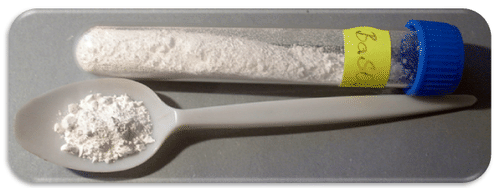19.14: Predicting Precipitates
- Page ID
- 53917
\( \newcommand{\vecs}[1]{\overset { \scriptstyle \rightharpoonup} {\mathbf{#1}} } \)
\( \newcommand{\vecd}[1]{\overset{-\!-\!\rightharpoonup}{\vphantom{a}\smash {#1}}} \)
\( \newcommand{\dsum}{\displaystyle\sum\limits} \)
\( \newcommand{\dint}{\displaystyle\int\limits} \)
\( \newcommand{\dlim}{\displaystyle\lim\limits} \)
\( \newcommand{\id}{\mathrm{id}}\) \( \newcommand{\Span}{\mathrm{span}}\)
( \newcommand{\kernel}{\mathrm{null}\,}\) \( \newcommand{\range}{\mathrm{range}\,}\)
\( \newcommand{\RealPart}{\mathrm{Re}}\) \( \newcommand{\ImaginaryPart}{\mathrm{Im}}\)
\( \newcommand{\Argument}{\mathrm{Arg}}\) \( \newcommand{\norm}[1]{\| #1 \|}\)
\( \newcommand{\inner}[2]{\langle #1, #2 \rangle}\)
\( \newcommand{\Span}{\mathrm{span}}\)
\( \newcommand{\id}{\mathrm{id}}\)
\( \newcommand{\Span}{\mathrm{span}}\)
\( \newcommand{\kernel}{\mathrm{null}\,}\)
\( \newcommand{\range}{\mathrm{range}\,}\)
\( \newcommand{\RealPart}{\mathrm{Re}}\)
\( \newcommand{\ImaginaryPart}{\mathrm{Im}}\)
\( \newcommand{\Argument}{\mathrm{Arg}}\)
\( \newcommand{\norm}[1]{\| #1 \|}\)
\( \newcommand{\inner}[2]{\langle #1, #2 \rangle}\)
\( \newcommand{\Span}{\mathrm{span}}\) \( \newcommand{\AA}{\unicode[.8,0]{x212B}}\)
\( \newcommand{\vectorA}[1]{\vec{#1}} % arrow\)
\( \newcommand{\vectorAt}[1]{\vec{\text{#1}}} % arrow\)
\( \newcommand{\vectorB}[1]{\overset { \scriptstyle \rightharpoonup} {\mathbf{#1}} } \)
\( \newcommand{\vectorC}[1]{\textbf{#1}} \)
\( \newcommand{\vectorD}[1]{\overrightarrow{#1}} \)
\( \newcommand{\vectorDt}[1]{\overrightarrow{\text{#1}}} \)
\( \newcommand{\vectE}[1]{\overset{-\!-\!\rightharpoonup}{\vphantom{a}\smash{\mathbf {#1}}}} \)
\( \newcommand{\vecs}[1]{\overset { \scriptstyle \rightharpoonup} {\mathbf{#1}} } \)
\( \newcommand{\vecd}[1]{\overset{-\!-\!\rightharpoonup}{\vphantom{a}\smash {#1}}} \)
\(\newcommand{\avec}{\mathbf a}\) \(\newcommand{\bvec}{\mathbf b}\) \(\newcommand{\cvec}{\mathbf c}\) \(\newcommand{\dvec}{\mathbf d}\) \(\newcommand{\dtil}{\widetilde{\mathbf d}}\) \(\newcommand{\evec}{\mathbf e}\) \(\newcommand{\fvec}{\mathbf f}\) \(\newcommand{\nvec}{\mathbf n}\) \(\newcommand{\pvec}{\mathbf p}\) \(\newcommand{\qvec}{\mathbf q}\) \(\newcommand{\svec}{\mathbf s}\) \(\newcommand{\tvec}{\mathbf t}\) \(\newcommand{\uvec}{\mathbf u}\) \(\newcommand{\vvec}{\mathbf v}\) \(\newcommand{\wvec}{\mathbf w}\) \(\newcommand{\xvec}{\mathbf x}\) \(\newcommand{\yvec}{\mathbf y}\) \(\newcommand{\zvec}{\mathbf z}\) \(\newcommand{\rvec}{\mathbf r}\) \(\newcommand{\mvec}{\mathbf m}\) \(\newcommand{\zerovec}{\mathbf 0}\) \(\newcommand{\onevec}{\mathbf 1}\) \(\newcommand{\real}{\mathbb R}\) \(\newcommand{\twovec}[2]{\left[\begin{array}{r}#1 \\ #2 \end{array}\right]}\) \(\newcommand{\ctwovec}[2]{\left[\begin{array}{c}#1 \\ #2 \end{array}\right]}\) \(\newcommand{\threevec}[3]{\left[\begin{array}{r}#1 \\ #2 \\ #3 \end{array}\right]}\) \(\newcommand{\cthreevec}[3]{\left[\begin{array}{c}#1 \\ #2 \\ #3 \end{array}\right]}\) \(\newcommand{\fourvec}[4]{\left[\begin{array}{r}#1 \\ #2 \\ #3 \\ #4 \end{array}\right]}\) \(\newcommand{\cfourvec}[4]{\left[\begin{array}{c}#1 \\ #2 \\ #3 \\ #4 \end{array}\right]}\) \(\newcommand{\fivevec}[5]{\left[\begin{array}{r}#1 \\ #2 \\ #3 \\ #4 \\ #5 \\ \end{array}\right]}\) \(\newcommand{\cfivevec}[5]{\left[\begin{array}{c}#1 \\ #2 \\ #3 \\ #4 \\ #5 \\ \end{array}\right]}\) \(\newcommand{\mattwo}[4]{\left[\begin{array}{rr}#1 \amp #2 \\ #3 \amp #4 \\ \end{array}\right]}\) \(\newcommand{\laspan}[1]{\text{Span}\{#1\}}\) \(\newcommand{\bcal}{\cal B}\) \(\newcommand{\ccal}{\cal C}\) \(\newcommand{\scal}{\cal S}\) \(\newcommand{\wcal}{\cal W}\) \(\newcommand{\ecal}{\cal E}\) \(\newcommand{\coords}[2]{\left\{#1\right\}_{#2}}\) \(\newcommand{\gray}[1]{\color{gray}{#1}}\) \(\newcommand{\lgray}[1]{\color{lightgray}{#1}}\) \(\newcommand{\rank}{\operatorname{rank}}\) \(\newcommand{\row}{\text{Row}}\) \(\newcommand{\col}{\text{Col}}\) \(\renewcommand{\row}{\text{Row}}\) \(\newcommand{\nul}{\text{Nul}}\) \(\newcommand{\var}{\text{Var}}\) \(\newcommand{\corr}{\text{corr}}\) \(\newcommand{\len}[1]{\left|#1\right|}\) \(\newcommand{\bbar}{\overline{\bvec}}\) \(\newcommand{\bhat}{\widehat{\bvec}}\) \(\newcommand{\bperp}{\bvec^\perp}\) \(\newcommand{\xhat}{\widehat{\xvec}}\) \(\newcommand{\vhat}{\widehat{\vvec}}\) \(\newcommand{\uhat}{\widehat{\uvec}}\) \(\newcommand{\what}{\widehat{\wvec}}\) \(\newcommand{\Sighat}{\widehat{\Sigma}}\) \(\newcommand{\lt}{<}\) \(\newcommand{\gt}{>}\) \(\newcommand{\amp}{&}\) \(\definecolor{fillinmathshade}{gray}{0.9}\)The invention of the x-ray machine radically improved medical diagnosis and treatment. For the first time, it was possible to see inside a person's body to detect broken bones, tumors, obstructions, and other problems. Barium sulfate is often used to examine patients with problems of the esophagus, stomach, and intestines. This insoluble compound coats the inside of the tissues and absorbs x-rays, allowing a clear picture of the interior structure of these organs.
Predicting Precipitates
Knowledge of \(K_\text{sp}\) values will allow you to be able to predict whether or not a precipitate will form when two solutions are mixed together. For example, suppose that a known solution of barium chloride is mixed with a known solution of sodium sulfate. Barium sulfate is a mostly insoluble compound, and so could potentially precipitate from the mixture. However, it is first necessary to calculate the ion product, \(\left[ \ce{Ba^{2+}} \right] \left[ \ce{SO_4^{2-}} \right]\), for the solution. If the value of the ion product is less than the value of the \(K_\text{sp}\), then the solution will remain unsaturated; no precipitate will form because the concentrations are not high enough to begin the precipitation process. If the value of the ion product is greater than the value of the \(K_\text{sp}\), then a precipitate will form. The formation of the precipitate lowers the concentration of each of the ions until the ion product is exactly equal to the \(K_\text{sp}\), at which point precipitation ceases.

Example \(\PageIndex{1}\)
Will a precipitate of barium sulfate form when \(10.0 \: \text{mL}\) of \(0.0050 \: \text{M} \: \ce{BaCl_2}\) is mixed with \(20.0 \: \text{mL}\) of \(0.0020 \: \text{M} \: \ce{Na_2SO_4}\)?
Solution
Step 1: List the known quantities and plan the problem.
Known
- Concentration of \(\ce{BaCl_2} = 0.0050 \: \text{M}\)
- Volume of \(\ce{BaCl_2} = 10.0 \: \text{mL}\)
- Concentration of \(\ce{Na_2SO_4} = 0.0020 \: \text{M}\)
- Volume of \(\ce{Na_2SO_4} = 20.0 \: \text{mL}\)
- \(K_\text{sp}\) of \(\ce{BaSO_4} = 1.1 \times 10^{-10}\)
Unknown
- Ion product \(= \left[ \ce{Ba^{2+}} \right] \left[ \ce{SO_4^{2-}} \right]\)
- If a precipitate forms.
The concentration and volume of each solution that is mixed together must be used to calculate the \(\left[ \ce{Ba^{2+}} \right]\) and the \(\left[ \ce{SO_4^{2-}} \right]\). Each individual solution is diluted when they are mixed together. The ion product is calculated and compared to the \(K_\text{sp}\) to determine if a precipitate forms.
Step 2: Solve.
The moles of each ion from the original solutions are calculated by multiplying the molarity by the volume in liters.
\[\text{mol} \: \ce{Ba^{2+}} = 0.0050 \: \text{M} \times 0.010 \: \text{L} = 5.0 \times 10^{-5} \: \text{mol} \: \ce{Ba^{2+}}\nonumber \]
\[\text{mol} \: \ce{SO_4^{2-}} = 0.0020 \: \text{M} \times 0.020 \: \text{L} = 4.0 \times 10^{-5} \: \text{mol} \: \ce{SO_4^{2-}}\nonumber \]
The concentration of each ion after dilution is then calculated by dividing the moles by the final solution volume of \(0.030 \: \text{L}\).
\[\left[ \ce{Ba^{2+}} \right] = \frac{5.0 \times 10^{-5} \: \text{mol}}{0.030 \: \text{L}} = 1.7 \times 10^{-3} \: \text{M}\nonumber \]
\[\left[ \ce{SO_4^{2-}} \right] = \frac{4.0 \times 10^{-5} \: \text{mol}}{0.030 \: \text{L}} = 1.3 \times 10^{-3} \: \text{M}\nonumber \]
Now, the ion product is calculated.
\[\left[ \ce{Ba^{2+}} \right] \left[ \ce{SO_4^{2-}} \right] = \left( 1.7 \times 10^{-3} \right) \left( 1.3 \times 10^{-3} \right) = 2.2 \times 10^{-6}\nonumber \]
Since the ion product is greater than the \(K_\text{sp}\), a precipitate of barium sulfate will form.
Step 3: Think about your result.
Two significant figures are appropriate for the calculated value of the ion product.

